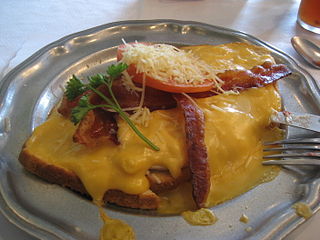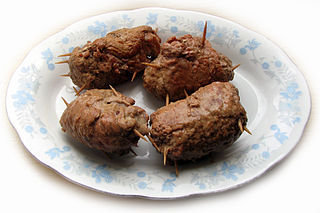
Polish cuisine is a style of food preparation originating in and widely popular in Poland. Due to Poland's history, Polish cuisine has evolved over the centuries to be very eclectic, and shares many similarities with other national cuisines. Polish cooking in other cultures is often referred to as à la polonaise.

Danish cuisine originated from the peasant population's own local produce and was enhanced by cooking techniques developed in the late 19th century and the wider availability of goods during and after the Industrial Revolution. Open sandwiches, known as smørrebrød, which in their basic form are the usual fare for lunch, can be considered a national speciality when prepared and garnished with a variety of ingredients. Hot meals are typically prepared with meat or fish. Substantial meat and fish dishes includes flæskesteg and kogt torsk with mustard sauce and trimmings. Ground meats became widespread during the industrial revolution and traditional dishes that are still popular include frikadeller, karbonader and medisterpølse. Denmark is known for its Carlsberg and Tuborg beers and for its akvavit and bitters, but amongst the Danes themselves imported wine has gained steadily in popularity since the 1960s.

Dutch cuisine is formed from the cooking traditions and practices of the Netherlands. The country's cuisine is shaped by its location in the fertile North Sea river delta of the European Plain, giving rise to fishing, farming and overseas trade. The Burgundian-Habsburg court enriched the cuisine of the Dutch elite in the 15th and 16th century, so did the colonial spice trade in the 17th century.

Cheese fries or cheesy chips is a dish consisting of French fries covered in cheese, with the possible addition of various other toppings. Cheese fries are generally served as a lunch or dinner dish. They can be found in fast-food locations, diners, and grills mainly in English speaking countries.
Sweet and sour is a generic term that encompasses many styles of sauce, cuisine, and cooking methods. It is commonly used in East Asia and Southeast Asia and has been used in England since the Middle Ages. Sweet and sour sauce remains popular in Asian and Western cuisines.

The cuisine of Kentucky mostly resembles that and is a part of traditional Southern cuisine. Some common dinner dishes are fried catfish and hushpuppies, fried chicken and country fried steak. These are usually served with vegetables such as green beans, greens, pinto beans slow-cooked with pork as seasoning and served with cornbread. Other popular items include fried green tomatoes, cheese grits, corn pudding, fried okra, and chicken and dumplings, which can be found across the commonwealth.

Silesian cuisine belongs to the region of Silesia in Central Europe. It is a subtype of Polish and German cuisine with many similarities to and signs of the influence of neighbouring cuisines. The cuisine is particularly renowned for its poppy seed and knödel dishes.

Chicken fried bacon consists of bacon strips dredged in batter and deep fried, like chicken fried steak. It is an American dish that was introduced in Texas in the early 1990s. Frank Sodolak of Sodolak's Original Country Inn in Snook, Texas, states that he invented the dish; however, there is a similar recipe in the 1954 cookbook Louisiana Cookery by Mary Land which uses salt pork instead of bacon. It is usually served as an appetizer with cream gravy or sausage gravy for dipping and sauce.

Chocolate-covered potato chips are a snack food consisting of potato chips that have been dipped into melted chocolate or cocoa, and coated with the chocolate. They are used for snacking like potato chips, and also served at parties or get togethers as appetizers and dessert items, especially in North Dakota.

Breaded cutlet or braised cutlet is a dish made from coating a cutlet of meat with breading or batter and either frying or baking it.

The traditional cuisine of Abruzzo is eclectic, drawing on pastoral, mountain, and coastal cuisine. Staples of Abruzzo cuisine include bread, pasta, meat, fish, cheese, and wine. The isolation which has characterized the region for centuries has ensured the independence of its culinary tradition from those of nearby regions. Local cuisine was widely appreciated in a 2013 survey among foreign tourists.

Clementine cake is a cake flavored primarily with clementines. It may be topped with a sweet glaze or sauce, powdered sugar, honey and clementines, or candied clementines. It may originate from an orange cake in Sephardic cuisine. In popular culture, the cake played a minor part in the plot of the 2013 film The Secret Life of Walter Mitty.

Salo in chocolate is a Ukrainian dish, created as a joke or experiment and produced since the late 1990s.
















